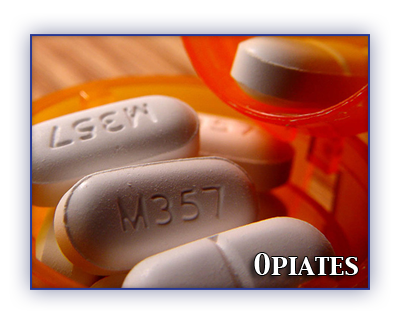Opiates are derived from a sap taken from a seed pod of the plant “papaver somniferum.”
Brand / Generic Names
Raw Opium, Opium, Codeine, Morphine, Heroin, Hydromorphone (Dilaudid), Oxycodone (Percodan), Oxymorphone (Numorphan), Hydrocodone (Vicodin), Meperidine (Demerol), Fentanyl, Methadone (Dolophine), Darvon, Talwin. Street Names Smack, Horse, Junk, “H”, Hard Stuff, Shit, Mexican Brown, China White, Chiva, Goma, Gumball, Schoolboy, Downtown, Dolls, Dollies, Drug Store Heroin, Miss Emma, Morf, “M”, Morpho, Big H, Black Tar, Boy, Brown Sugar, Crown Crap, Doogie, Hairy, Harry, Hazel, Henry, George Smack, Him, Horse Radish, Joy Powder, Mud, Muzzle, Scag, Schmeck, Smeck, Tecata, White Lady.
Possible Effects of Opiates
General effects of narcotic analgesics include: sedation, slowed reflexes, raspy speech, sluggish “rubber-like” movements, slowed breathing, cold skin, and possible vomiting. However, as a user continues to abuse narcotic analgesics he or she will build a tolerance to the drug, therefore causing the effects to diminish. Heroin, a very strong narcotic depressant, completely destroys the users ability to reason. Its synthetic form, known as “designer drug” has been proven to be even more deadly and addictive. If the abuser wishes to maintain the same effect, he or she will have to take steadily larger doses as the tolerance develops.
Heroin users generally experience certain psychological effects immediately after injection. These include a feeling of euphoria: relief from withdrawal symptoms: and, relief from pain. Physical effects, if they are evident at all, typically will become evident after 15-30 minutes. Physical effects may not be evident if the user is tolerant and has taken a normal dose. With new users, the physical effects include: nodding off, poor motor coordination, depressed reflexes, and slow breathing.
Withdrawal Symptoms
If a user is addicted to opiates he or she will suffer withdrawal symptoms if they don’t receive another dose, or “fix”, before the drug is completely out of their system. Withdrawal effects can be chills, aches of the muscles and joints, nausea and insomnia. These symptoms normally start 4-6 hours after the last dosage of the drug. The withdrawal signs and symptoms intensify from 14-24 hours following the injection, and may be accompanied by gooseflesh, slight tremors, loss of appetite and dilation of the pupils. Approximately 24-36 hours since the last “fix”, the addict experiences insomnia, vomiting, diarrhea, weakness, depression and hot/cold flashes. Withdrawal signs and symptoms generally reach their peak after 2-3 days. At this point, the addict usually experiences muscular and abdominal cramps, elevated temperature and severe tremors and twitching. This twitching, especially of the legs, is referred to in the expression “kickin’ the habit”. The addict is very nauseated at this time, may gag and vomit repeatedly, and may lose 10-15 pounds within 24 hours.
Overdose Signs
Overdose signs of narcotic analgesics are depressed respiration, slow and shallow breathing, clammy skin, convulsions, possible coma and death.

